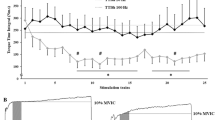Abstract
Low-frequency fatigue (LFF) is defined as a greater loss of force that occurs in during low versus high frequencies of stimulation. In order to determine which types of fatigue protocols are most likely to induce LFF, ten individuals participated in four different fatigue experiments which induced similar reductions in maximal force output as following: (1) 2-min intermittent high-frequency stimulation (40 Hz), (2) 4-min intermittent low-frequency stimulation (20 Hz), (3) sustained 100% maximal voluntary contraction (MVC), and (4) low-force voluntary contractions (20% MVC). Short (5s) trains of 10, 20, 30, 40, and 80 Hz were used to determine the force-versus-frequency relationships before and after the fatigue tasks. LFF was higher following the low-force voluntary contractions compared to the high-force voluntary and evoked contractions. The degree of LFF during the low-force voluntary contractions was most highly correlated to the duration of the fatigue task and to a lesser extent, to the decrease in maximal force output and the force–time integrals during the fatigue task.





Similar content being viewed by others
References
Baker LL, Wederich CL, McNeal DR, Newsam C, Waters RL (2000) Neuromuscular electrical stimulation, 4th edn. Los Amigos Research & Education Institute, Downy
Bergstrom M, Hultman E (1990) Contraction characteristics of the human quadriceps muscle during percutaneous electrical stimulation. Pflugers Arch 417:136–141
Bigland-Ritchie B, Jones DA, Woods JJ (1979) Excitation frequency and muscle fatigue: electrical responses during human voluntary and stimulated contractions. Exp Neurol 64:414–427
Binder-Macleod SA, McDermond LR (1992) Changes in the force-frequency relationship of the human quadriceps femoris muscle following electrically and voluntarily induced fatigue. Phys Ther 72:14–23
Binder-Macleod SA, Russ DW (1999) Effects of activation frequency and force on low-frequency fatigue in human skeletal muscle. J Appl Physiol 86:1337–1346
Blangsted AK, Sjogaard G, Madeleine P, Olsen HB, Sogaard K (2005) Voluntary low-force contraction elicits prolonged low-frequency fatigue and changes in surface electromyography and mechanomyography. J Electromyogr Kinesiol 15:138–148
Burke RE, Levine DN, Tsairis P, Zajac FE (1973) Physiological types and histochemical profiles in motor units of the cat gastrocnemius. J Physiol (Lond) 234:723–748
Chin ER, Allen DG (1996) The role of elevations in intracellular [Ca2+] i in the development of low frequency fatigue in mouse single muscle fibers. J Physiol (Lond) 491:813–824
de Ruiter CJ, Elzinga MJH, Verdijk PWL, van Mechelen W de Haan A (2005) Changes in force, surface and motor unit EMG during post-exercise developments of low frequency fatigue in vastus lateralis muscle. Eur J Appl Physiol 94:659–669
Duchateau J, Hainaut K (1986) Nonlinear summation of contractions in striated muscle I. Twitch potentiation in human muscle. J Musc Res Cell Motil 7:11–17
Edwards RHT, Hill DK, Jones DA, Merton PA (1977) Fatigue of long duration in human skeletal muscle after exercise. J Physiol (Lond) 272:769–778
Enoka RM, Fuglevand AJ (2001) Motor unit physiology: some unresolved issues. Muscle Nerve 24:4–17
Fuglevand AJ, Keen DA (2003) Re-evaluation of muscle wisdom in the human adductor pollicis using physiological rates of stimulation. J Physiol (Lond) 549:865–875
Fuglevand AJ, Zackowski KM, Huey KA, Enoka RM (1993) Impairment of neuromuscular propagation during human fatiguing contractions at submaximal forces. J Physiol (Lond) 460:549–572
Gandevia SC (2001) Spinal and supraspinal factors in human muscle fatigue. Physiol Rev 81:1725–1789
Garland SJ, Griffin L, Ivanova T (1997) Motor unit discharge rate is not associated with muscle relaxation time in sustained submaximal contractions in humans. Neurosci Lett 239:25–28
Griffin L, Jun BG, Covington C, Doucet BM (2008) Force output during fatigue with progressively increasing stimulation frequency. J Electromyogr Kinesiol (in press)
Hunter SK, Duchateau J, Enoka RM (2004) Muscle fatigue and the mechanisms of task failure. Exerc Sport Sci Rev 32:44–49
Iguchi M, Baldwin K, Boeyink C, Engle C, Kehoe M, Ganju A, Messaros AJ, Shields RK (2008) Low frequency fatigue in human quadriceps is fatigue dependent and not task dependent. J Electromyogr Kinesiol (in press)
Indurthy M, Griffin L (2008) Effect of random interpulse interval modulation on neuromuscular fatigue. Muscle Nerve (in press)
Jones DA, Bigland-Ritchie B, Edwards RH (1979) Excitation frequency and muscle fatigue: mechanical responses during voluntary and stimulated contractions. Exp Neurol 64:401–413
Kebaetse MB, Binder-Macleod SA (2004) Strategies that improve human skeletal muscle performance during repetitive, non-isometric contractions. Pflugers Arch 448:525–532
Lannergren J, Westerblad H (1991) Force decline due to fatigue and intracellular acidification in isolated fibres from mouse muscle. J Physiol (Lond) 434:307–322
Marsden CD, Meadows JC, Merton PA (1983) “Muscular wisdom” that minimizes fatigue during prolonged effort in man: peak rates of motoneuron discharge and slowing of discharge during fatigue. Adv Neurol 39:169–211
Mellor R, Stokes MJ (1992) Detection and severity of low frequency fatigue in the human adductor pollicis muscle. J Neurol Sci 108:196–201
Person RS, Kudina LP (1972) Discharge frequency and discharge pattern of human motor units during voluntary contraction of muscle. Electroencephalogr Clin Neurophysiol 32:471–483
Plaskett CJ, Cafarelli E (2001) Caffeine increases endurance and attenuates force sensation during submaximal isometric contractions. J Appl Physiol 91:1535–1544
Rakos M, Freudenschub B, Girsch W, Hofer C, Kaus J, Meiners T, Paternostro T, Mayr (1999) Electromyogram-controlled functional electrical stimulation for treatment of the paralyzed upper extremity. Artif Organs 23:466–469
Skurvydas A, Mamkus G, Stanislovaitis A, Mickeviciene D, Bulotiene D, Masiulis N (2003) Low frequency fatigue of quadriceps muscle after sustained maximum voluntary contractions. Medicina 39:1094–1099
Vollestad NK, Sejersted I, Saugen E (1997) Mechanical behavior of skeletal muscle during intermittent voluntary isometric contractions in humans. J Appl Physiol 83: 1557–1565
Winer BJ, Brown DR, Michels KM (1991) Statistical principles in experimental design. McGraw-Hill, New York
Author information
Authors and Affiliations
Corresponding author
Rights and permissions
About this article
Cite this article
Griffin, L., Anderson, N.C. Fatigue in high- versus low-force voluntary and evoked contractions. Exp Brain Res 187, 387–394 (2008). https://doi.org/10.1007/s00221-008-1310-3
Received:
Accepted:
Published:
Issue Date:
DOI: https://doi.org/10.1007/s00221-008-1310-3




